Ihr Warenkorb ist derzeit leer!
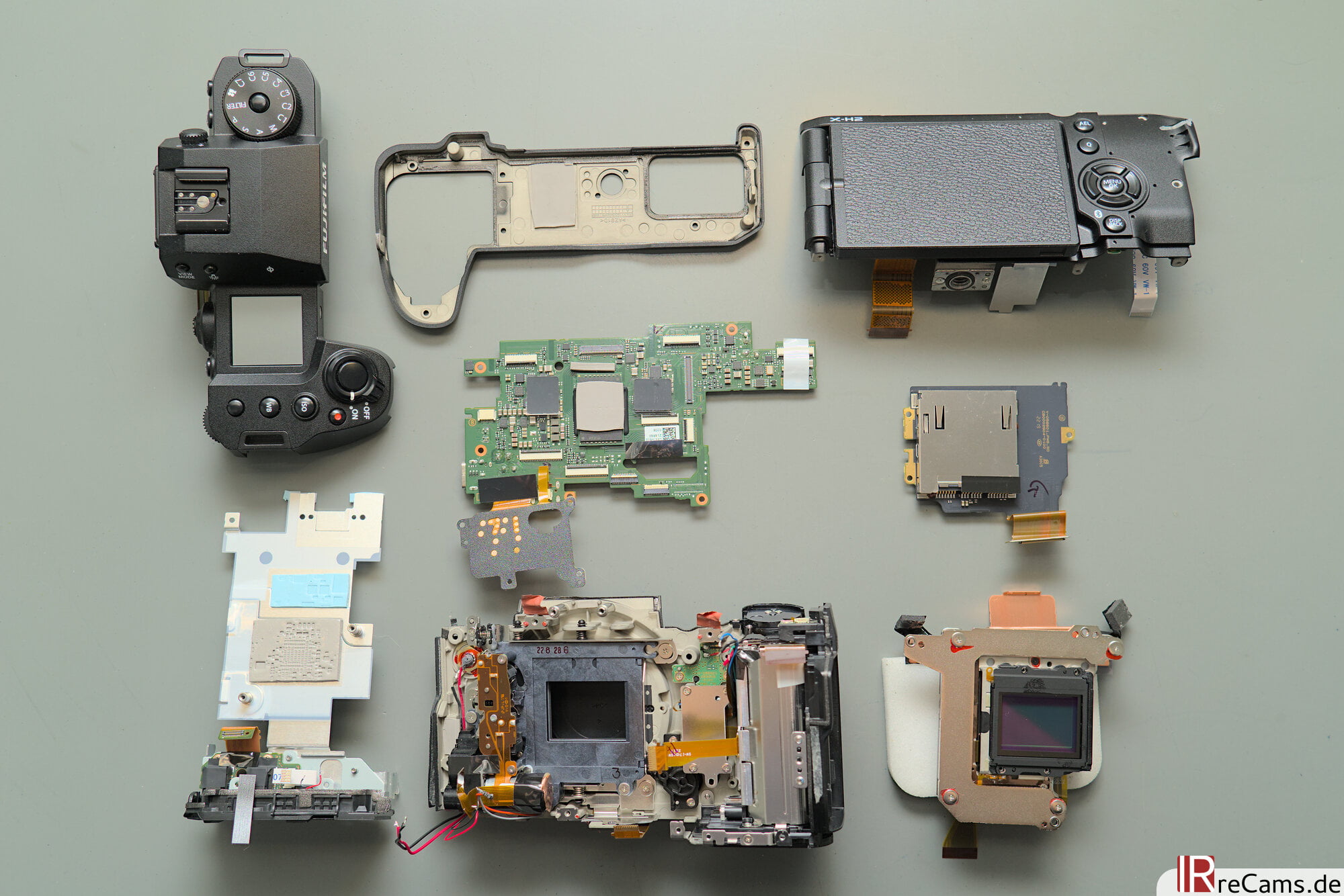
Insider: Fujifilm X-H2 Teardown and Disassembly
In the fall of 2022, Fujifilm introduced the X-H2, the first camera with the new X-Trans CMOS 5 HR sensor. This sensor has an effective resolution of 40 megapixels, making it the leader in the APS-C segment. Combined with the new X-Processor 5, which enables advanced subject detection and video capture up to 8K RAW, this flagship camera is aimed at professionals and enthusiasts. After a deep look under the hood, the design of this camera can be summarized as follows: Heat Management and Dissipation. But how does it perform in Infrared Photography?
Important:The camera has been modified by routined professionals, please do not attempt to do this at home. This article is not a guide and there will be no assistance from our side to convert your camera. If you do decide to open your camera, IRreCams is not responsible or liable for any damage or problems resulting from your actions.
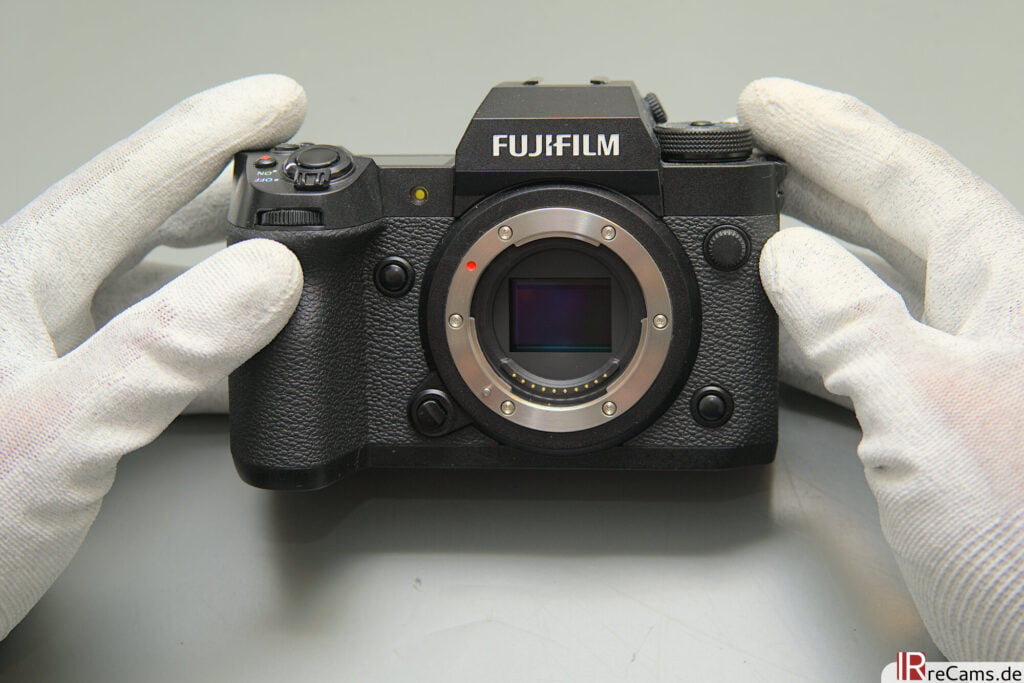
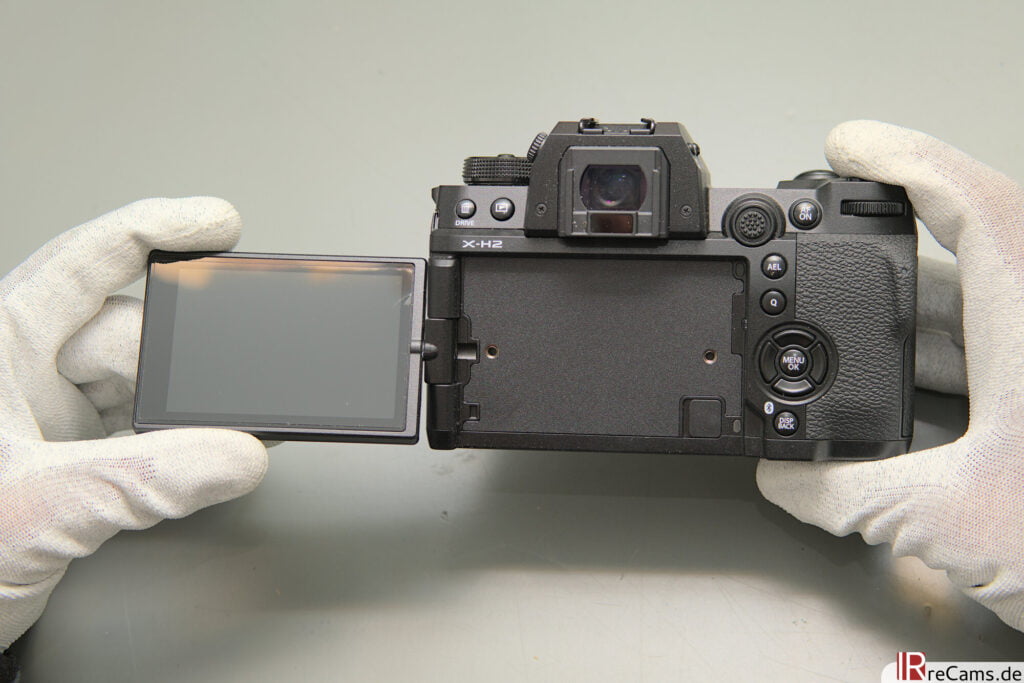
Disassembly and Teardown of the X-H2
Externally, relatively few screws can be seen on the casing. As with other Fuji cameras, the usual ones are quickly found. Let's start at the bottom - there are no surprises here and everything is open and accessible.
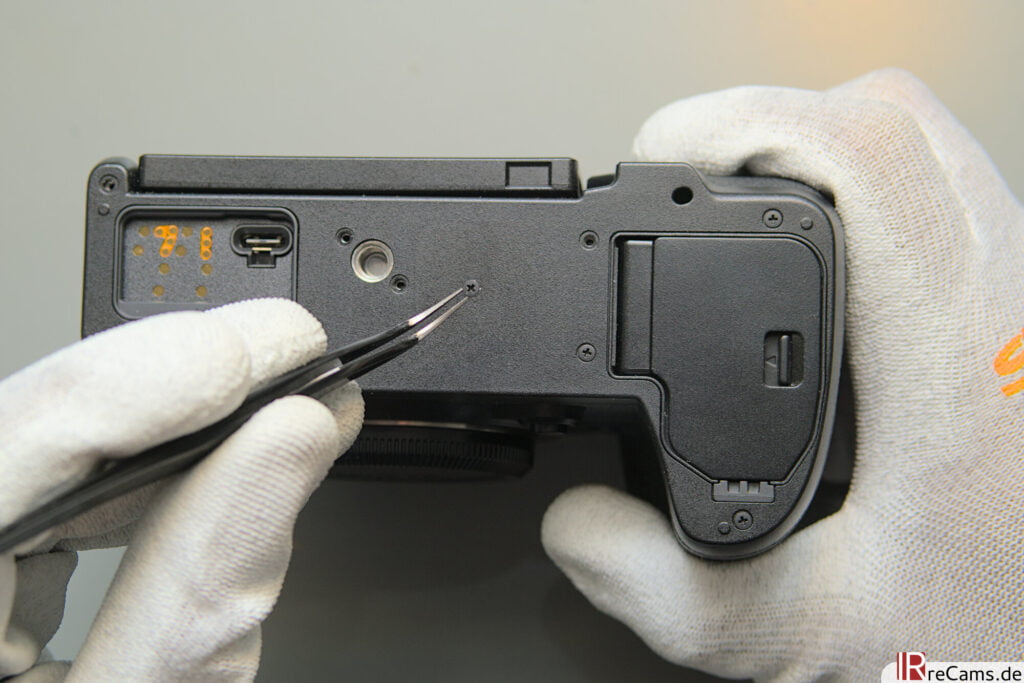
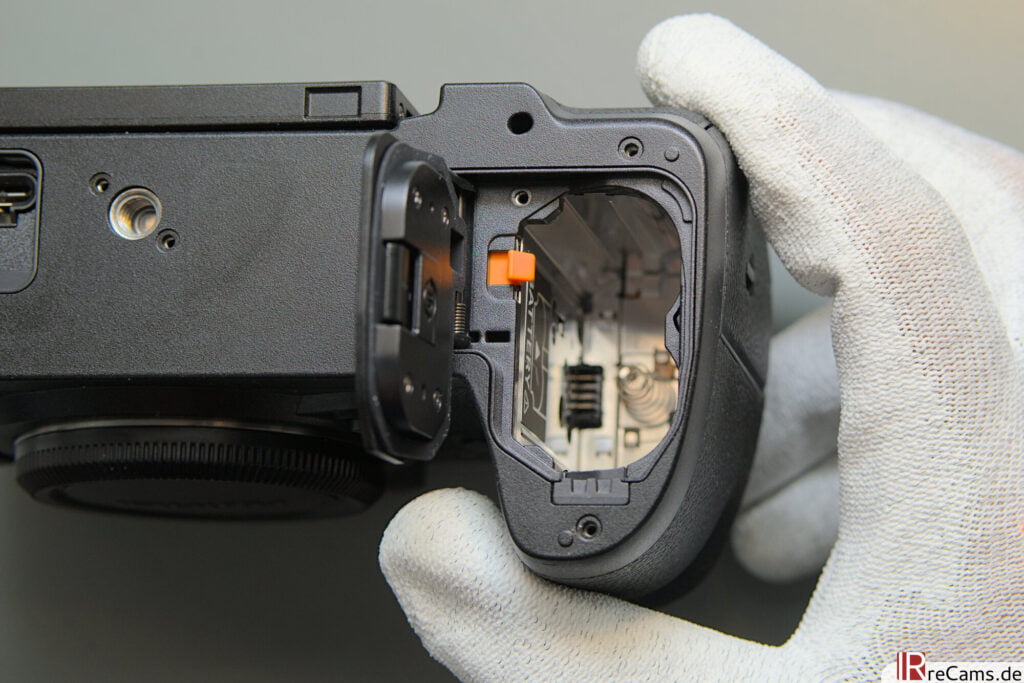
A few screws are accessible around the casing, but many are also hidden under the rubber coating.
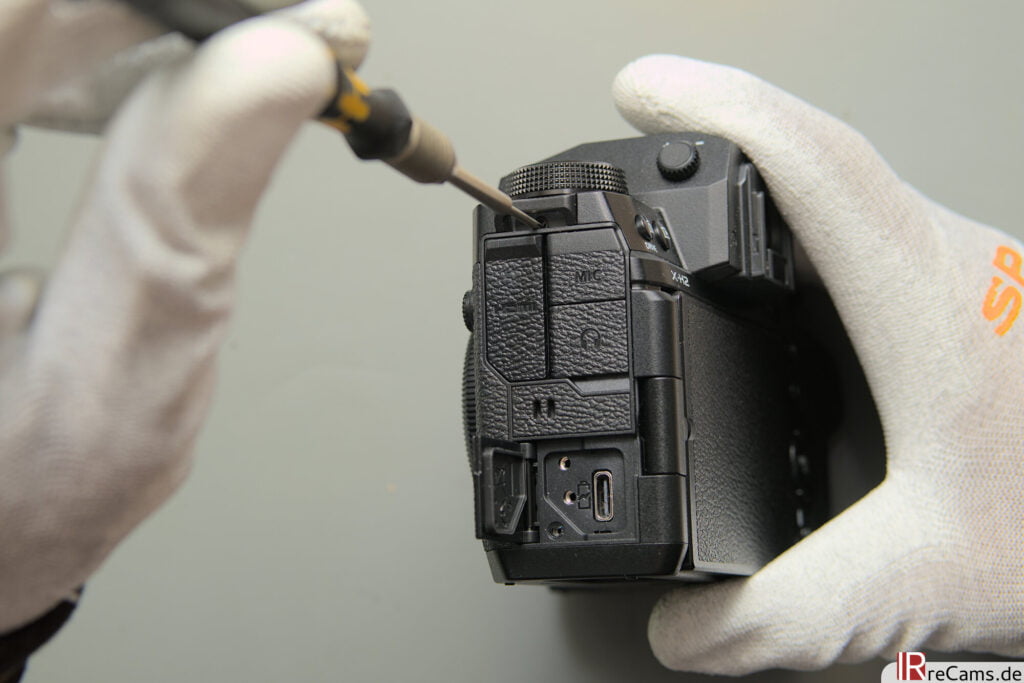
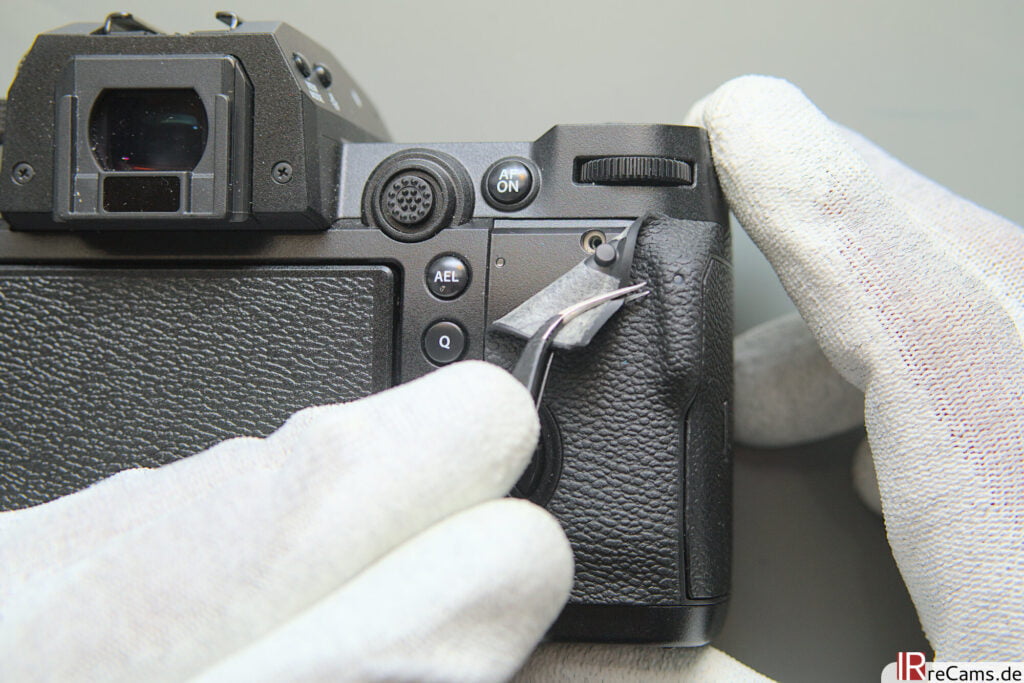
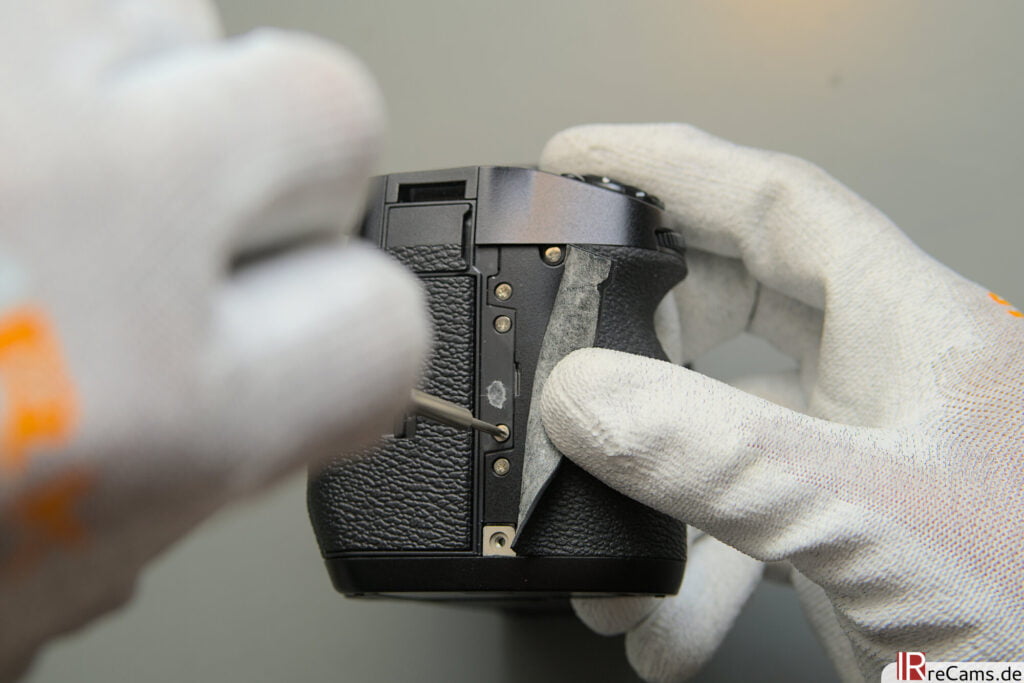
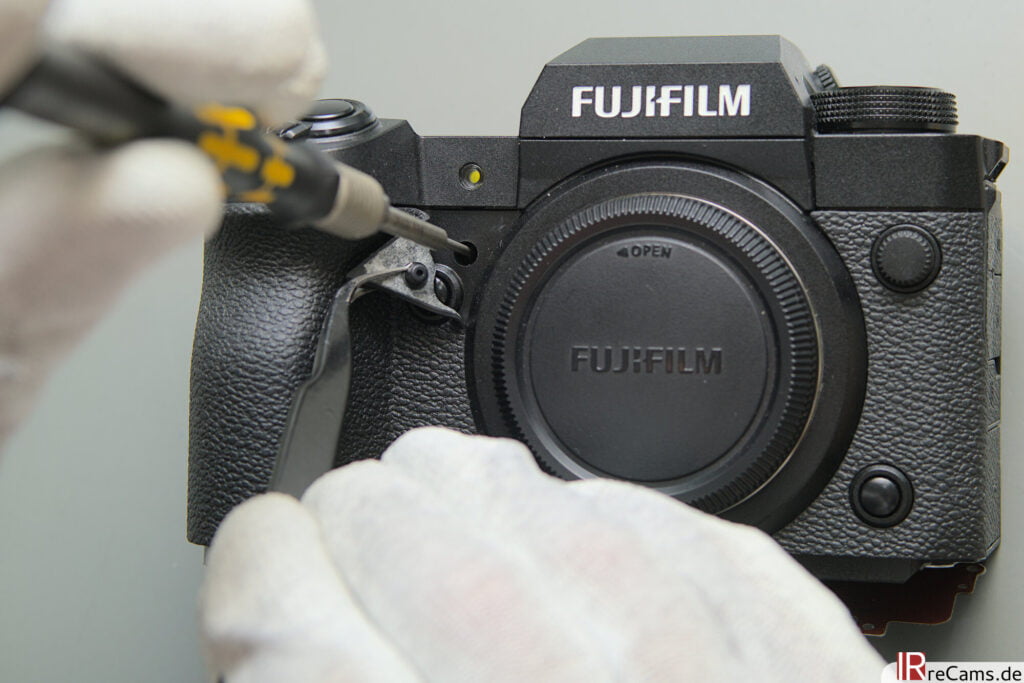
After the screws are removed, the bottom can be removed and reveals the first view of the inner parts. The first thing that stands out is a large aluminum surface on the right of the tripod thread. This surface is connected to the bottom via a heat conduction pad to dissipate heat from the inside.
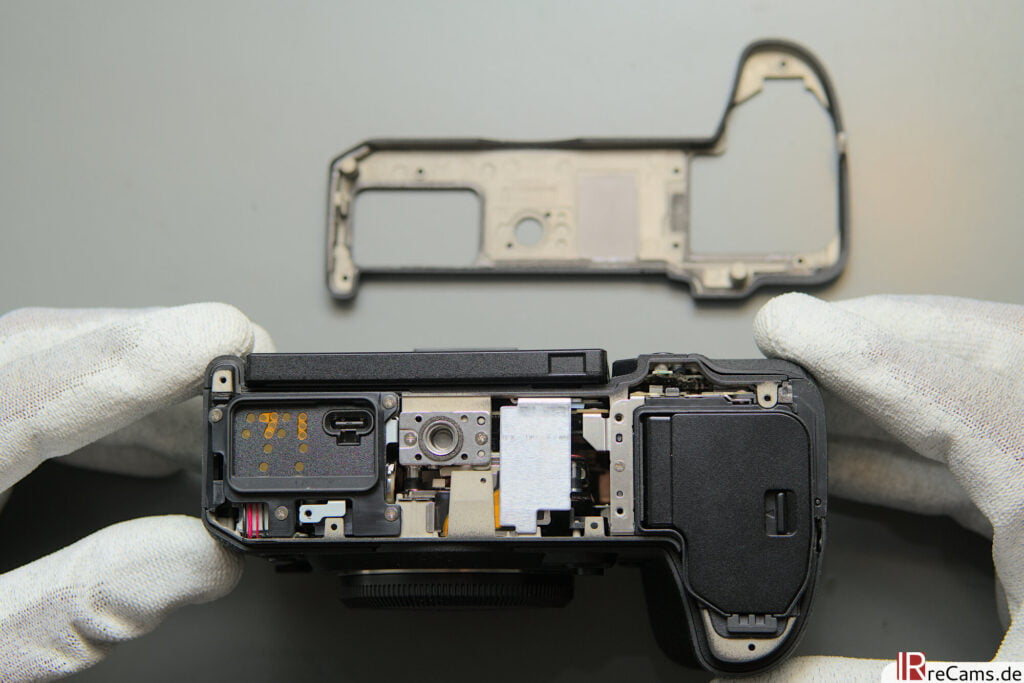
Hinter dem Display ist neben 2 Gewindelöchern und einer elektrischen Schnittstelle nicht viel zu sehen. Diese Anschlüsse sind für den optionalen Lüfter, “FAN-001” welcher die Rückseite der Kamera aktiv kühlen kann. Ein paar weitere Schrauben sind unter einer dicken Folie auf der Rückseite zu finden (eine Design-Entscheidung, die irgendwie sehr an die Zeit der X-A1 erinnert). Nachdem die letzten Schrauben entfernt sind, kann das Rückteil samt Klappdisplay ausgebaut werden und gibt den Blick auf das Mainboard frei.
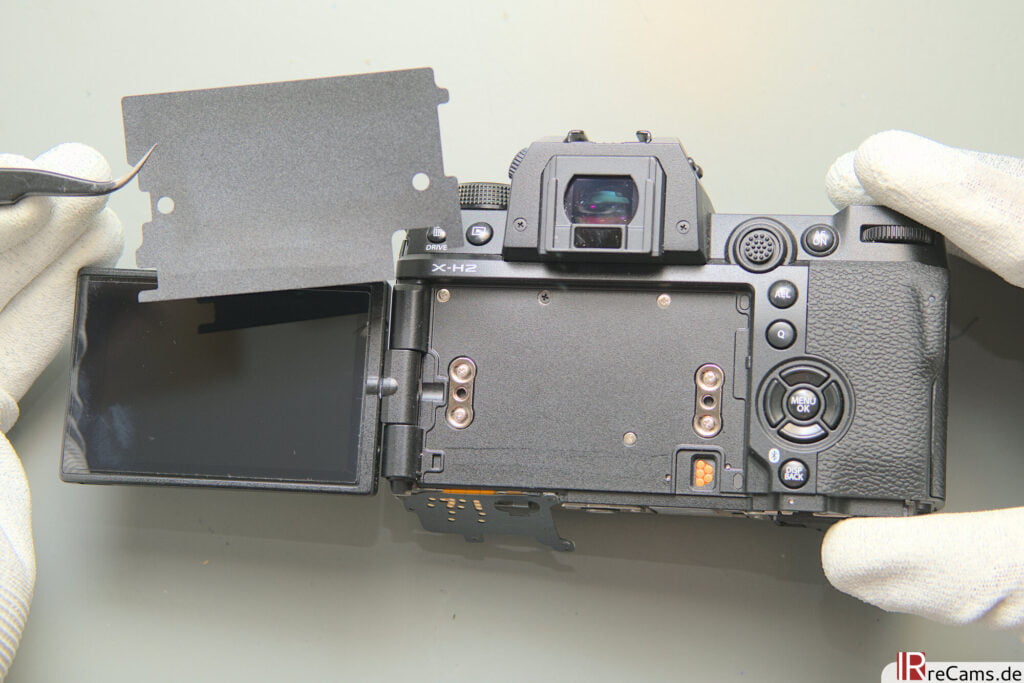
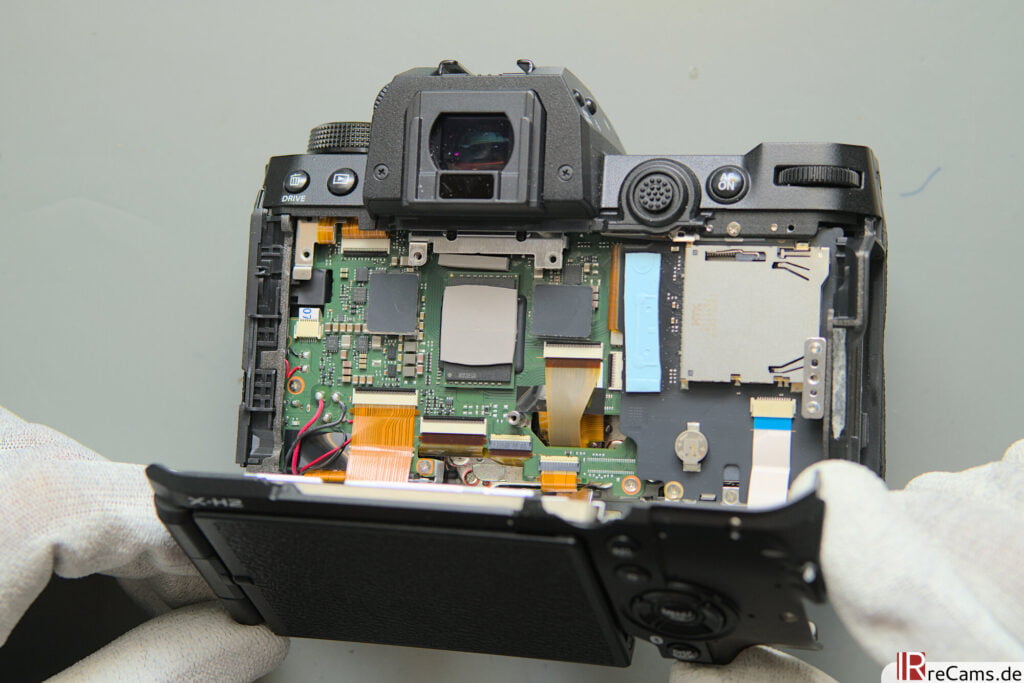
Auf der Innenseite des Rückteils finden sich dann eine große Aluminiumplatte, welche für die Wärmeableitung zuständig ist. Über Wärmeleitpads wird die Abwärme diverser Komponenten des Mainboards, allem voran die Abwärme des Prozessors, direkt in diese Platte eingeleitet und verteilt. Über die Rückseite hinter dem Display (Stichwort “FAN-001”) und den Boden kann diese Wärme dann an die Umgebung abgeführt werden.
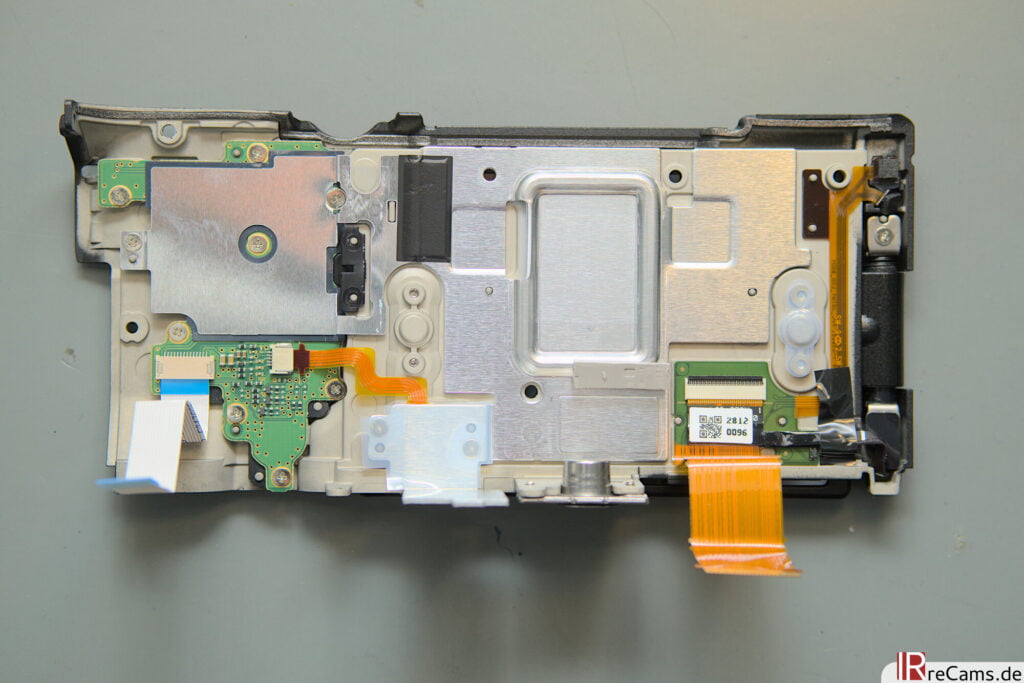
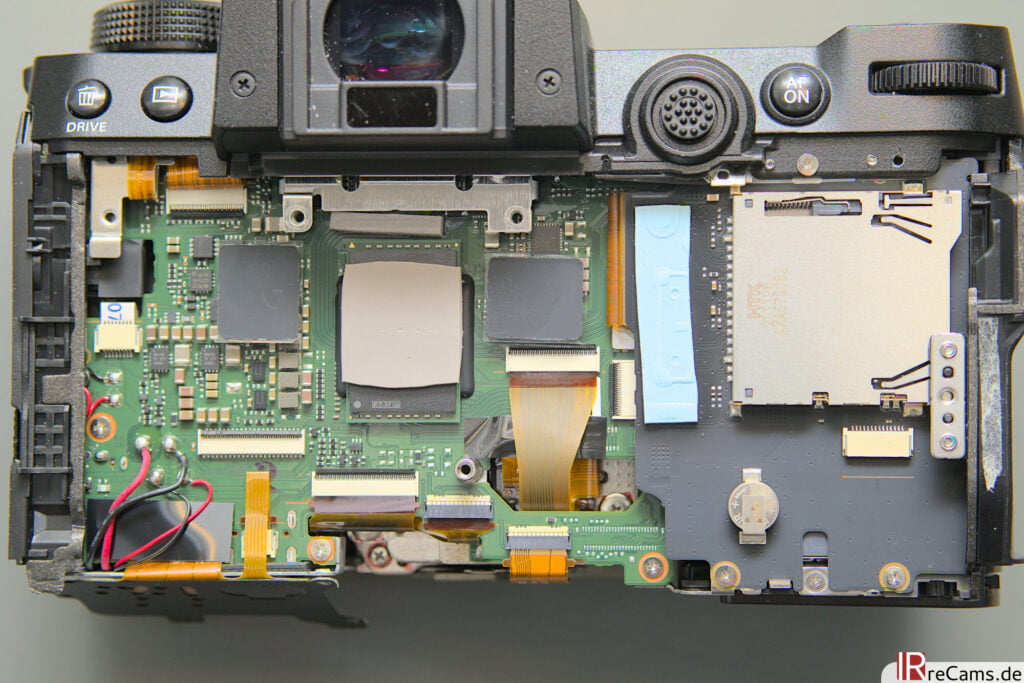
Next, the upper part including the viewfinder has to make way. All screens and buttons of the upper camera case are connected to the mainboard via 3 cables. A small copper contact surface and heat pad is also noticeable here. Later, it becomes clear where the heat comes from: The heat is conducted directly from the sensor into the upper case in front of the viewfinder.
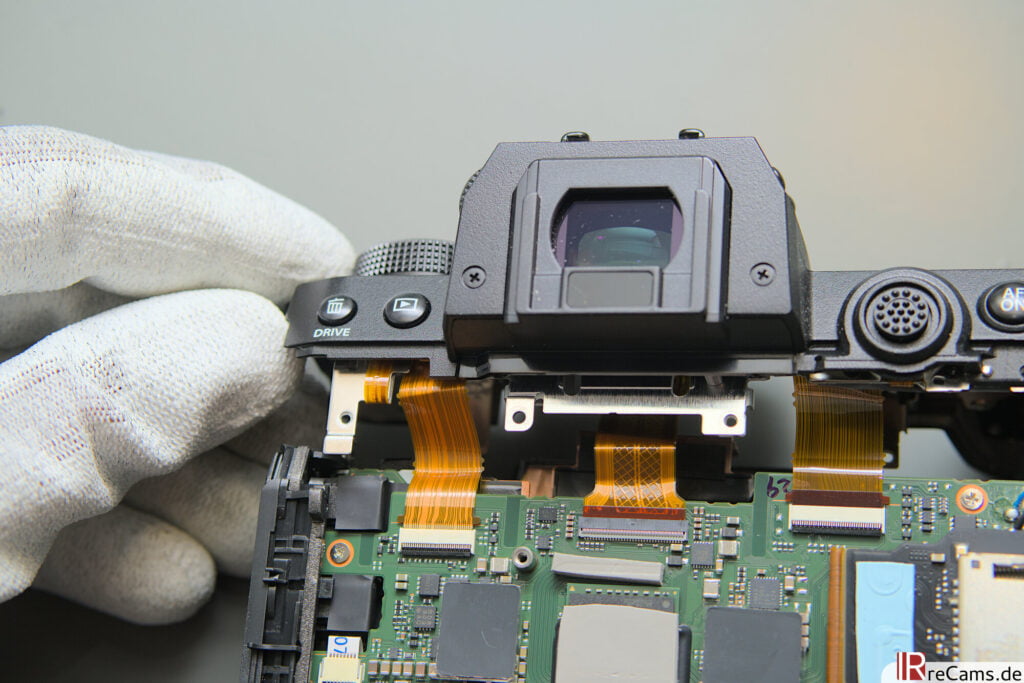
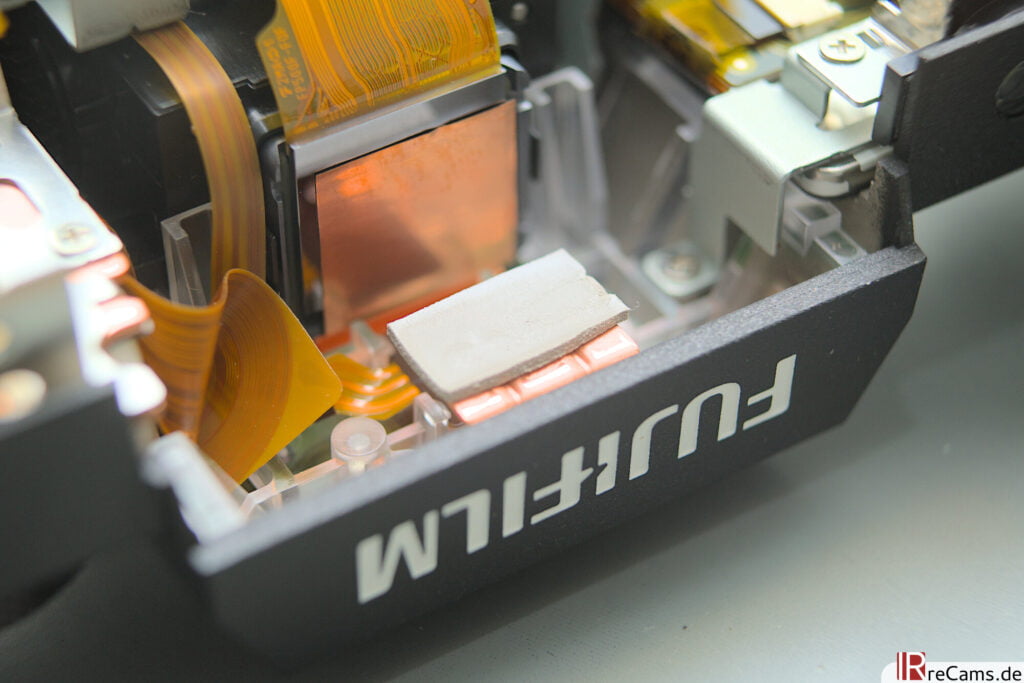
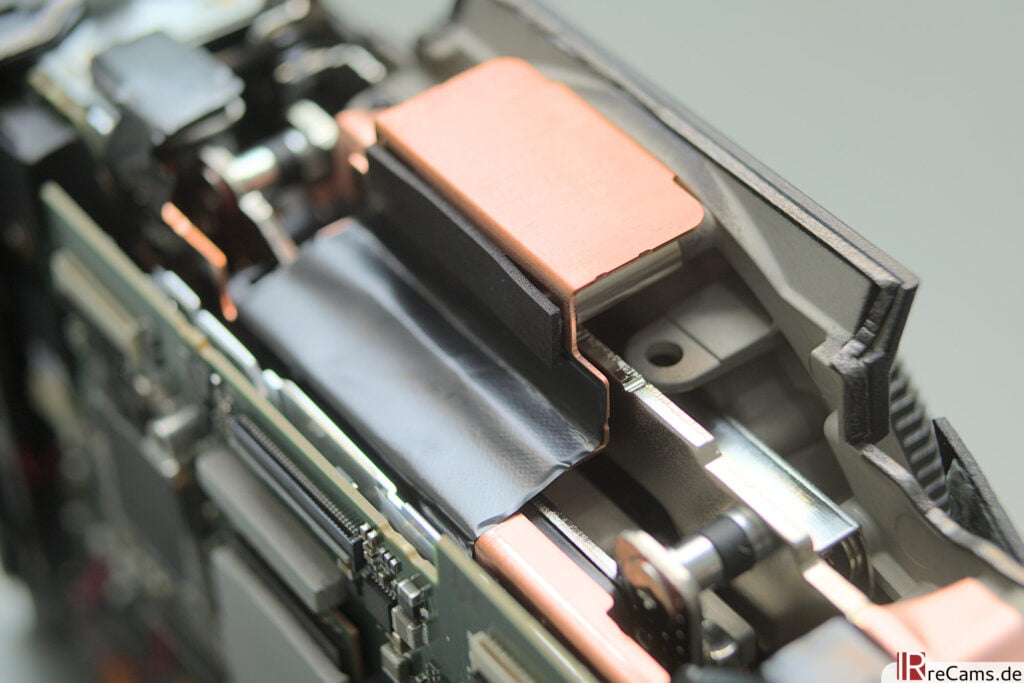
The two card slots (SD and CFexpress) have their own small circuit board, which has to be removed first, with only 3 screws it is done quickly. This design element was carried over from the X-T4, except that there are 2 SD card slots in the X-T4.
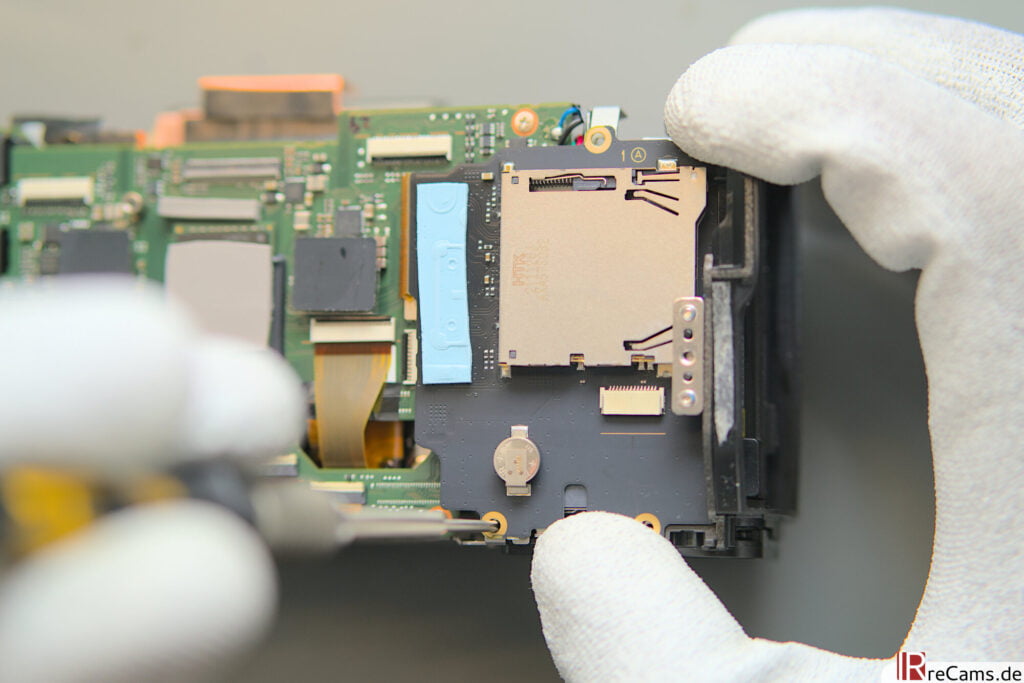
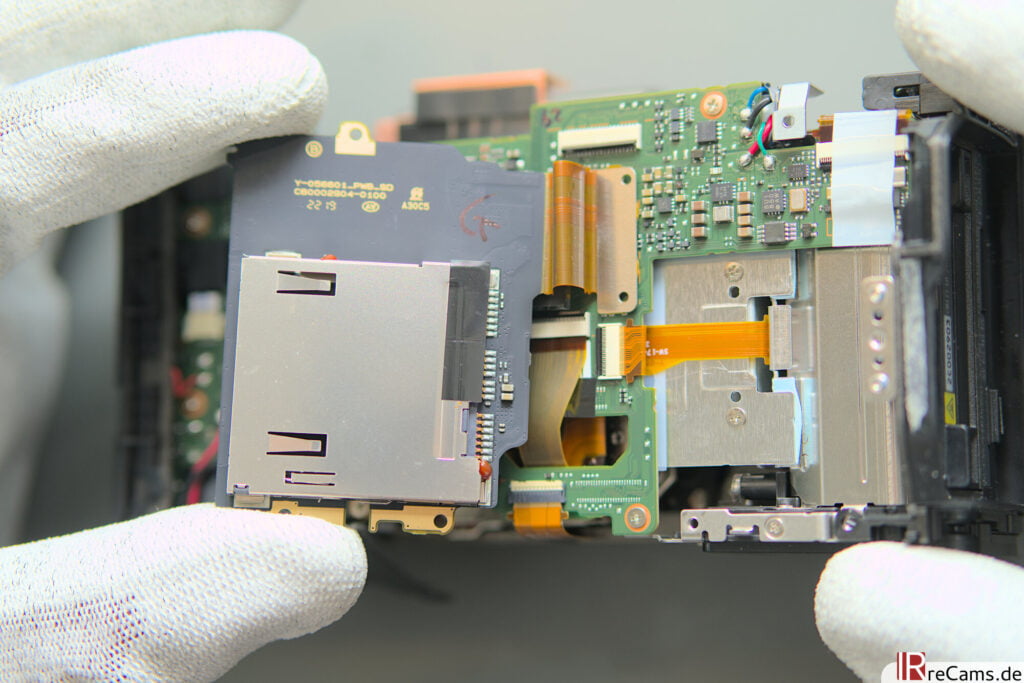

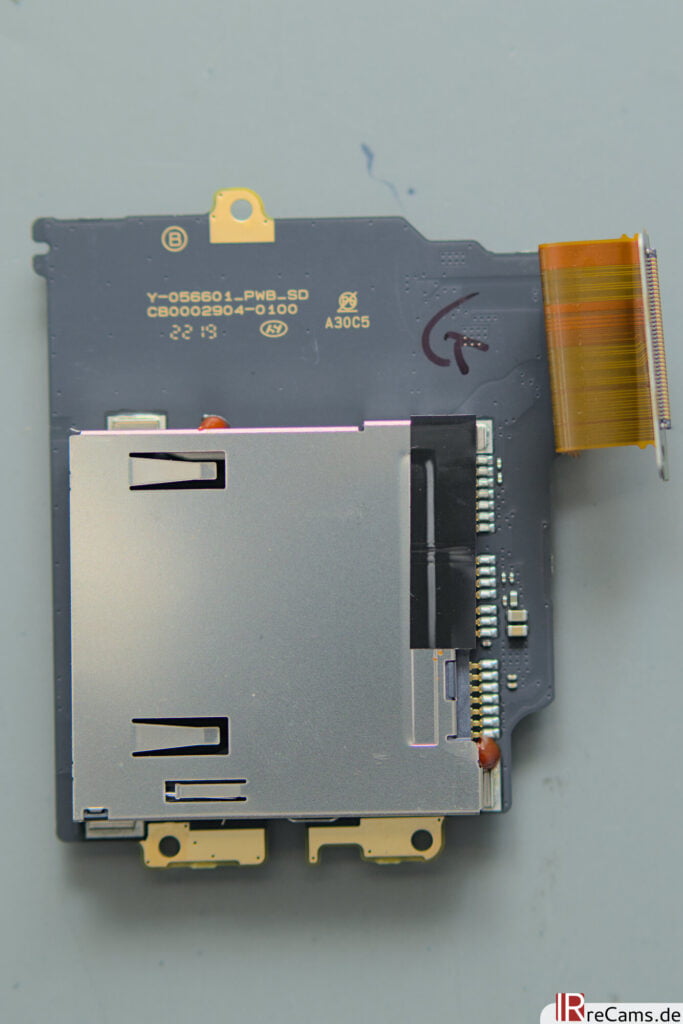
Next, the mainboard has to leave the camera. Besides some cables on the top and a handful of screws, there are also a few cables to unsolder. Similar to the X-T4, there are other cables on the underside that have to be carefully detached.
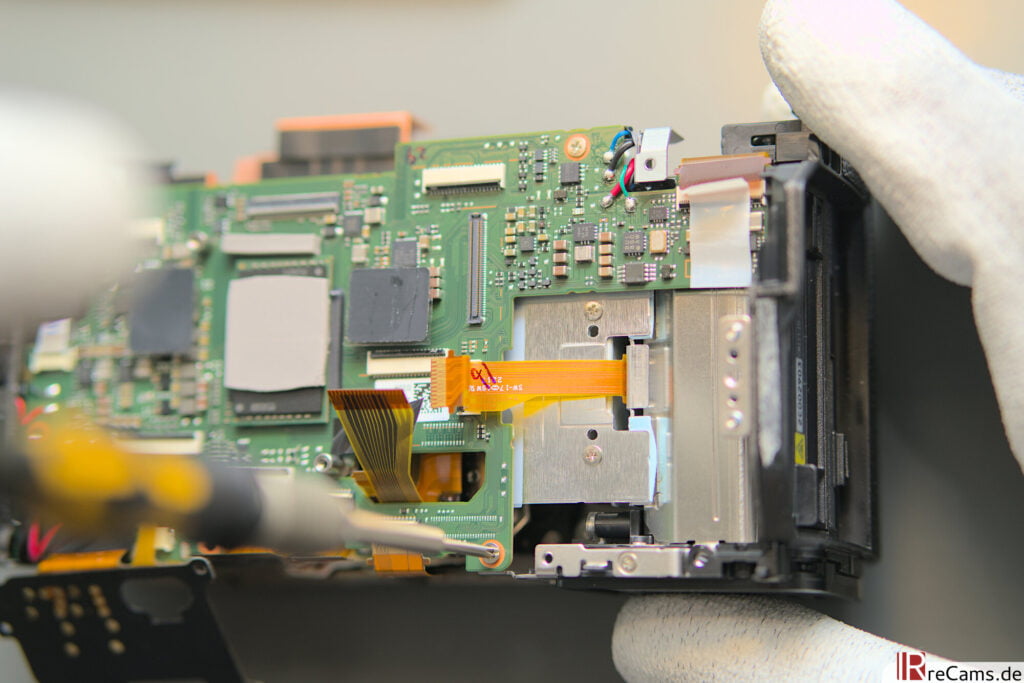
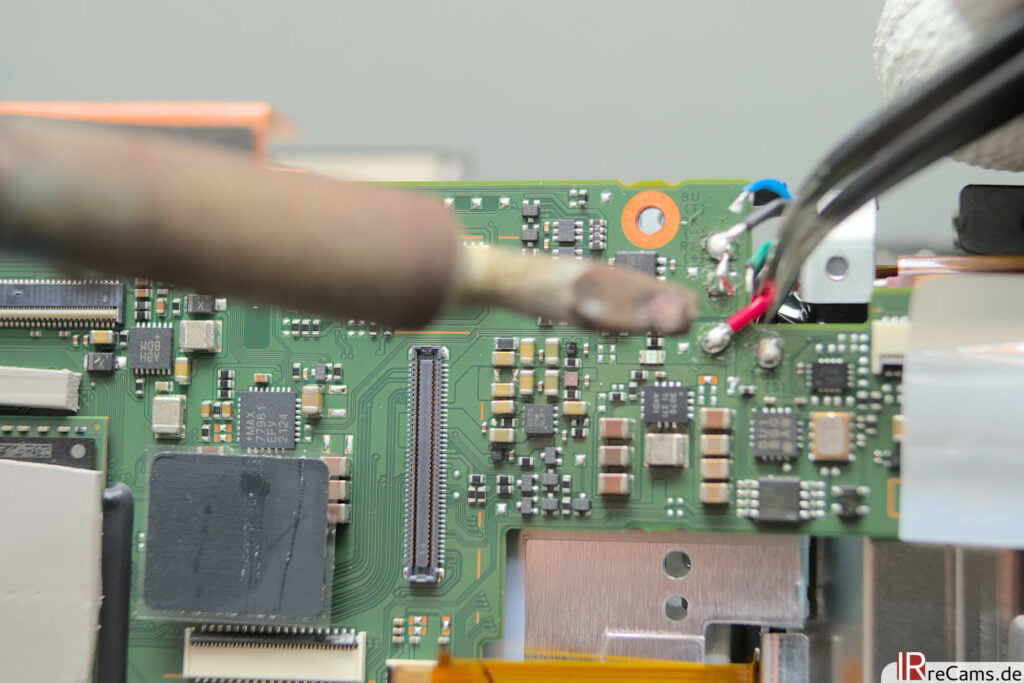
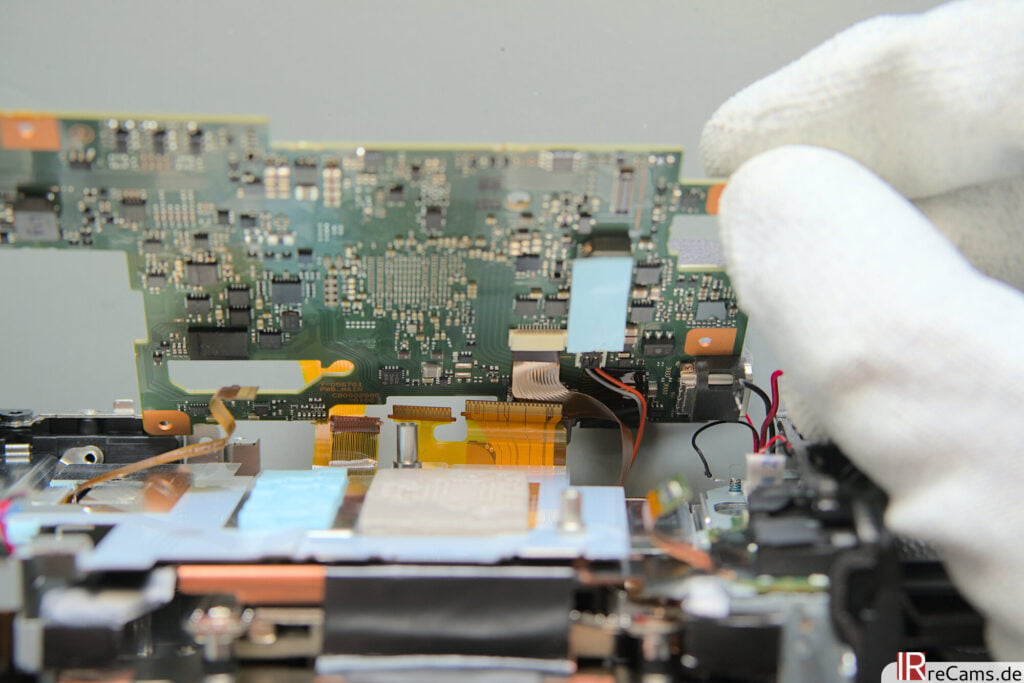
A closer look at the removed mainboard of the X-H2 reveals countless SMD components, both on the top and the bottom. With the amount of features packed into such a small camera, this is hardly surprising. The new X-Processor 5 is placed in the middle of the board, and it's slightly higher than the rest of the board. It seems to be installed on a small socket, almost floating above the other components. Whether this was designed because of the heat development, or has entirely different reasons, can only be speculated. In any case, the processor is covered with a heat conduction pad and thus establishes the already mentioned connection to the camera's back plate.
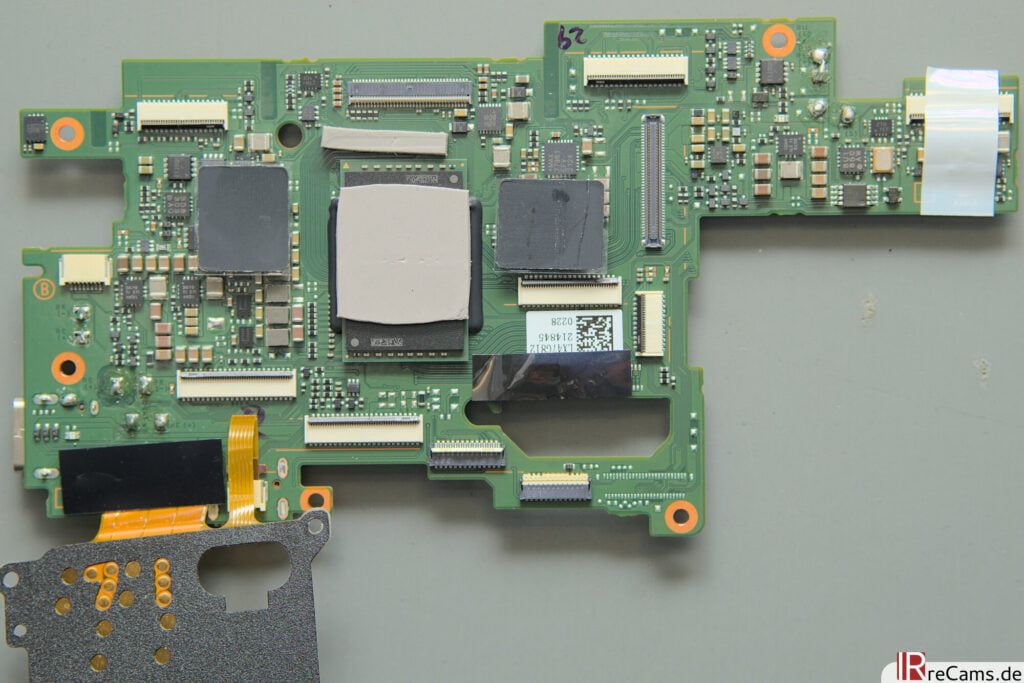
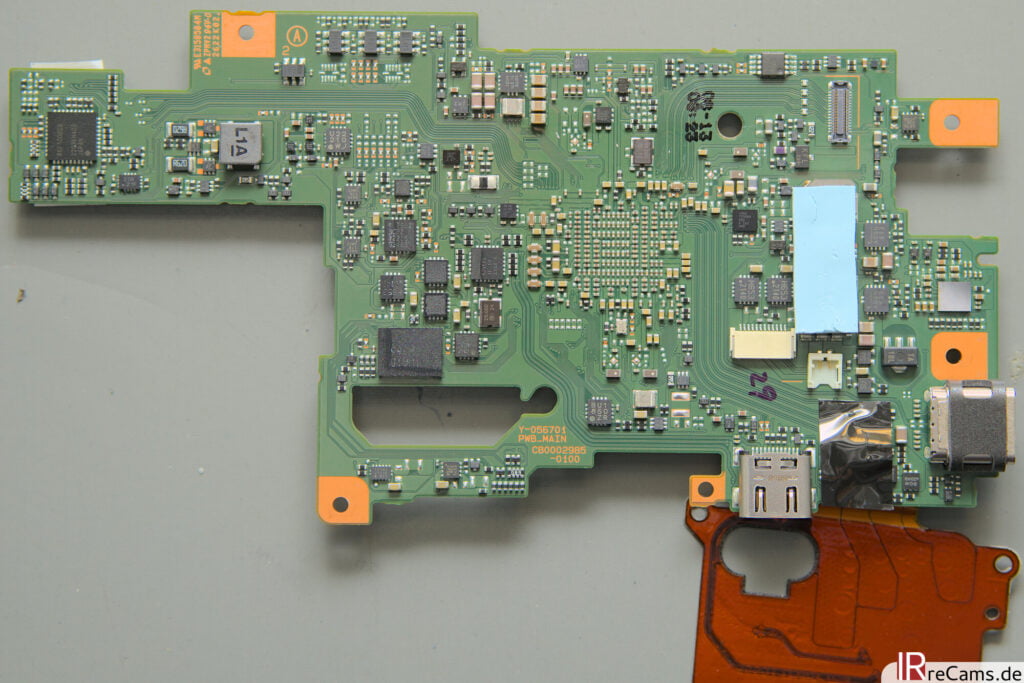
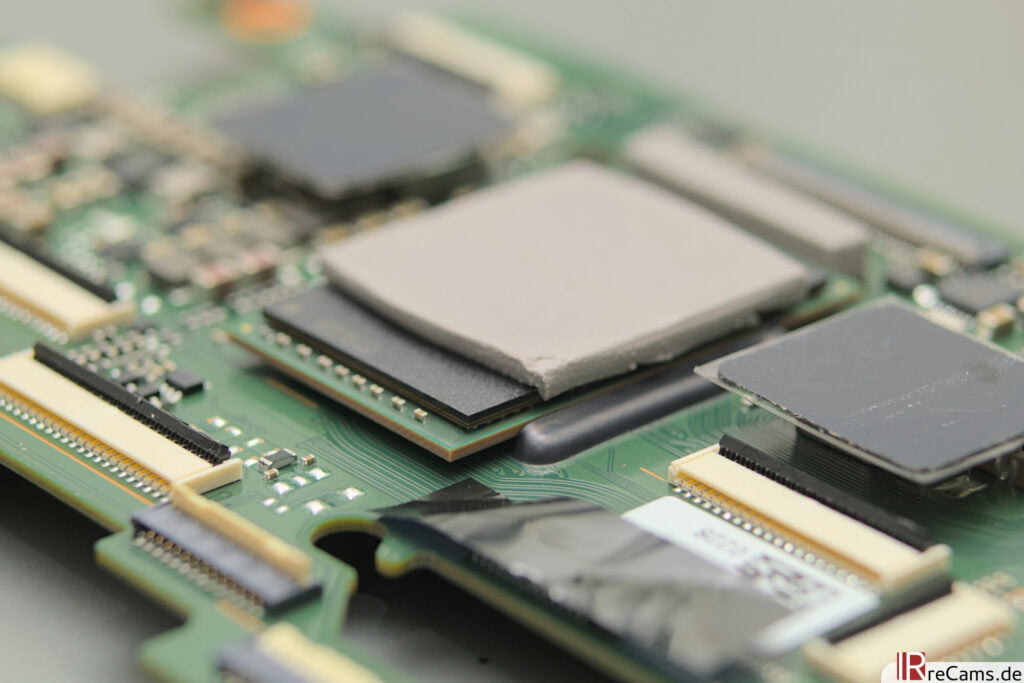
Back to the camera: Directly underneath the removed mainboard is another aluminum plate with large heat conduction pads. This middle frame is probably not only responsible for the mechanical stability of the camera, but also absorbs the excess heat of the SMD components on the underside of the motherboard and dissipates it. Interestingly, the mini board on the left side should also be mentioned. The microphone and headphone jack are integrated here. Many manufacturers now build these into higher-end cameras on separate small circuit boards instead of integrating them directly onto the motherboard. I can only speculate, but presumably the noise performance is a bit better when these connectors are more clearly separated from the rest of the electronics.
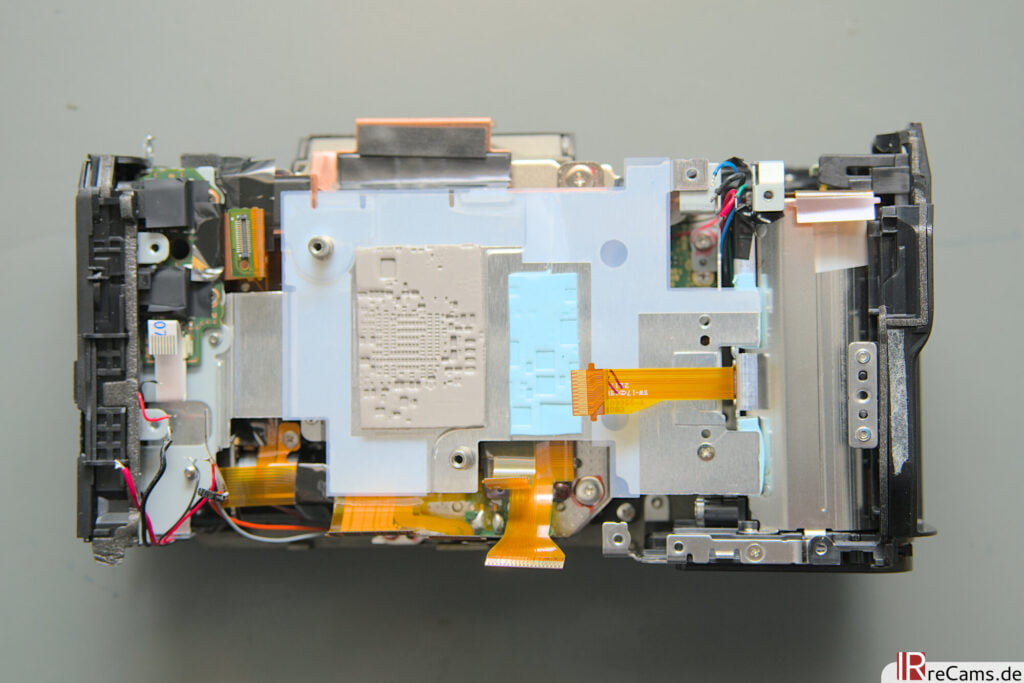
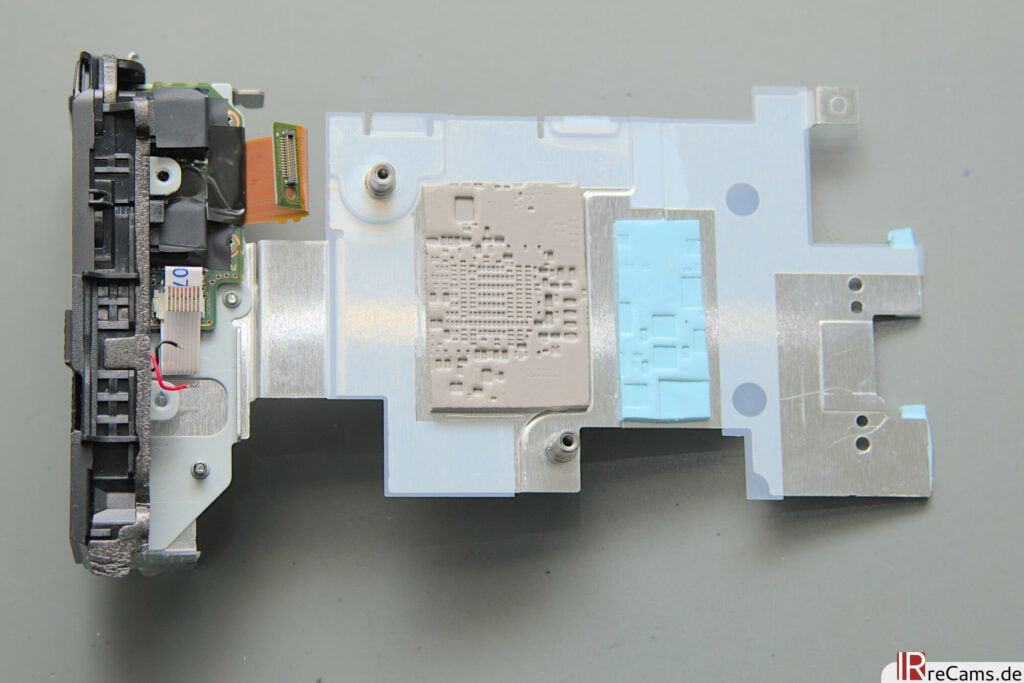

Just below the center frame, the IBIS unit with the new X-Trans 5 HR sensor is visible. Next to the shutter mechanism and the battery compartment, you can clearly see how much space this component takes up in the camera. The module can be removed relatively quickly and easily with 3 screws.
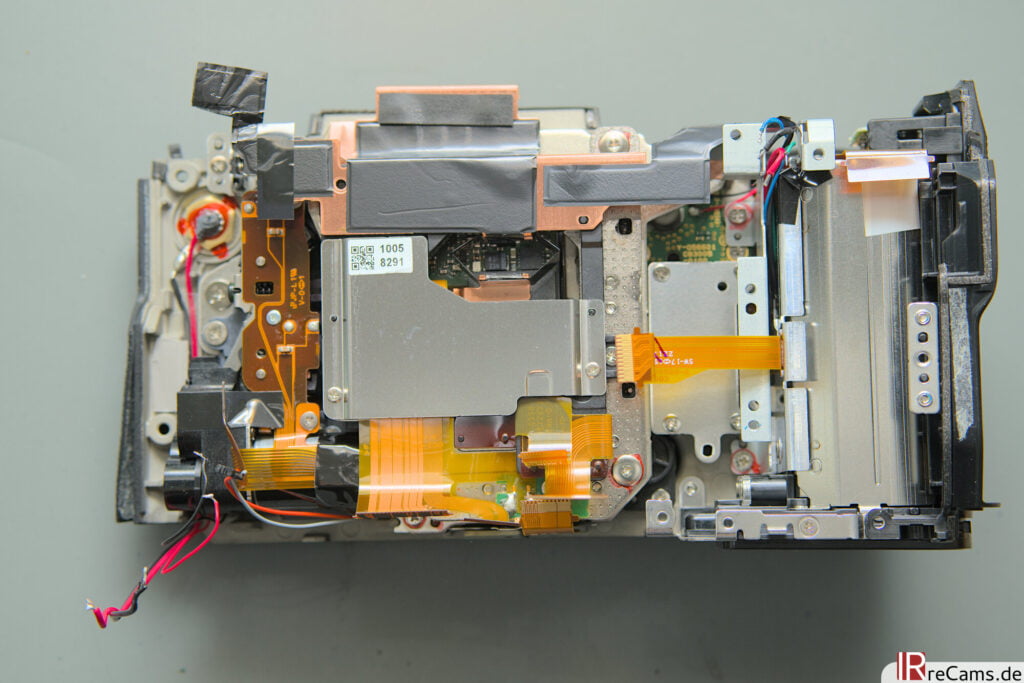

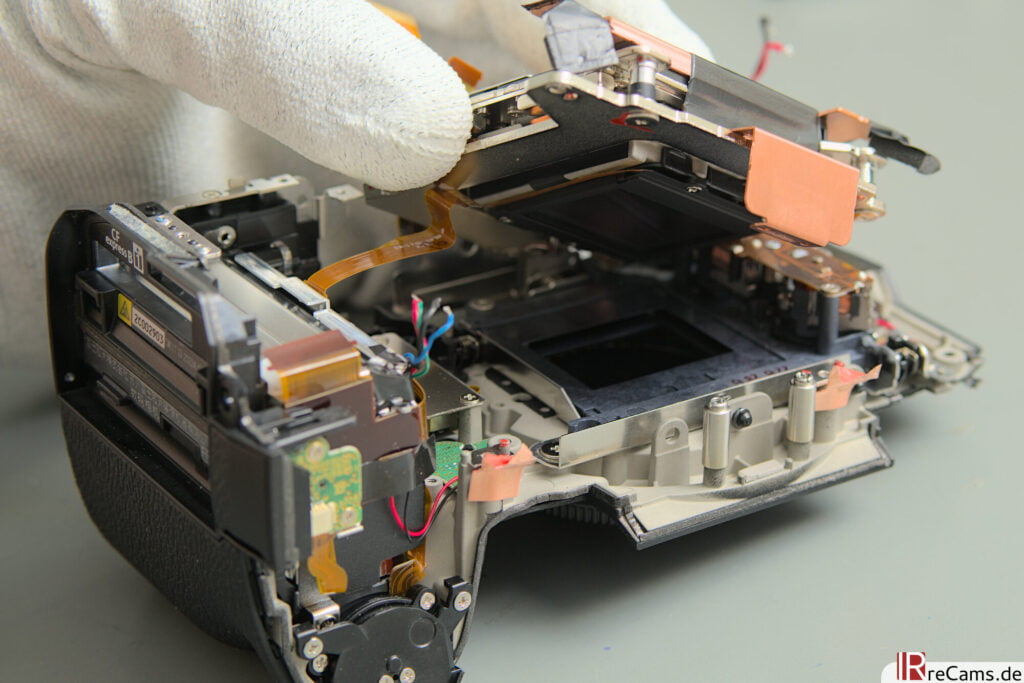
Before we turn to the sensor, a quick look at the shutter underneath. The entire shutter mechanism is supported by small springs all around and has no direct contact with the body. This was already present on the X-H1 and has been adopted on the X-H2. Compared to other cameras like the X-T3 or X-T4, this also explains why the camera's shutter is relatively quiet and has this very special muted sound.
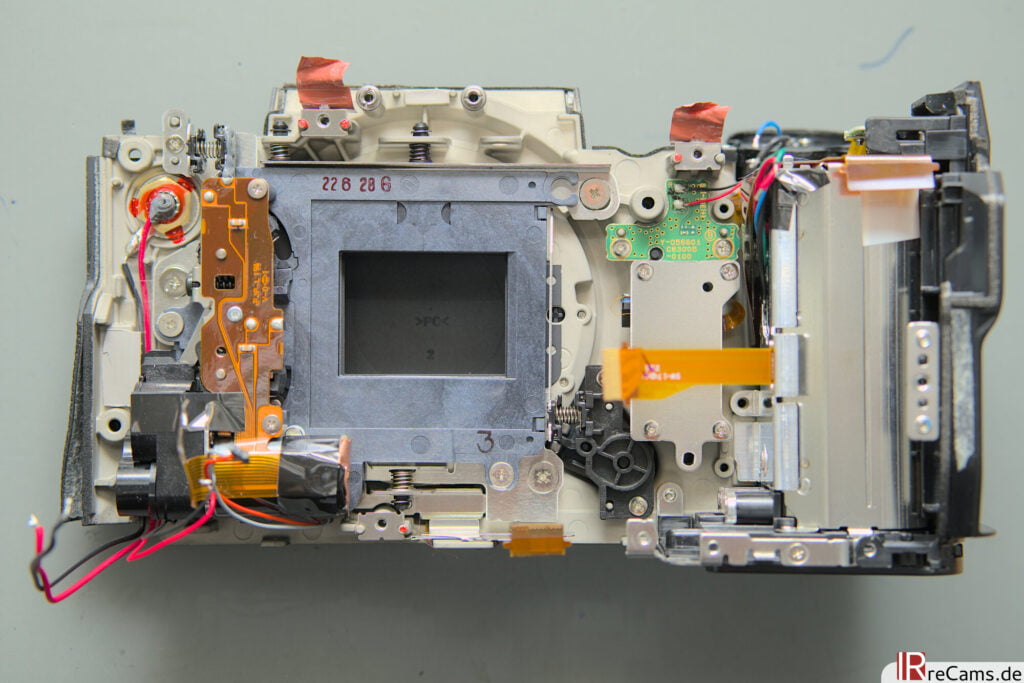

Zurück zum Sensor: Das IBIS Modul besteht aus einem massiven Edelstahl Chassis, auf dem mehrere sehr starke Dauermagnete (vermutlich Neodym) angebracht sind. In diesem Konstrukt ist der Sensor beweglich auf einer Metallplatte gelagert, auf der sich diverse Kupferspulen befinden – das sind Elektromagnete. Durch die gezielte Ansteuerung der Elektromagnete kann der Sensor extrem präzise in 5 Achsen bewegt und platziert werden. Laut Fujifilm kompensiert die Sensorstabilisierung nicht nur bis zu 7 Blendenstufen, sie kann den Sensor auch pixelgenau für die “Multi Shift Pixel Aufnahme” platzieren. Durch Kombination von 20 einzelnen Aufnahmen kann damit eine Auflösung von 160 Megapixeln erreicht werden.
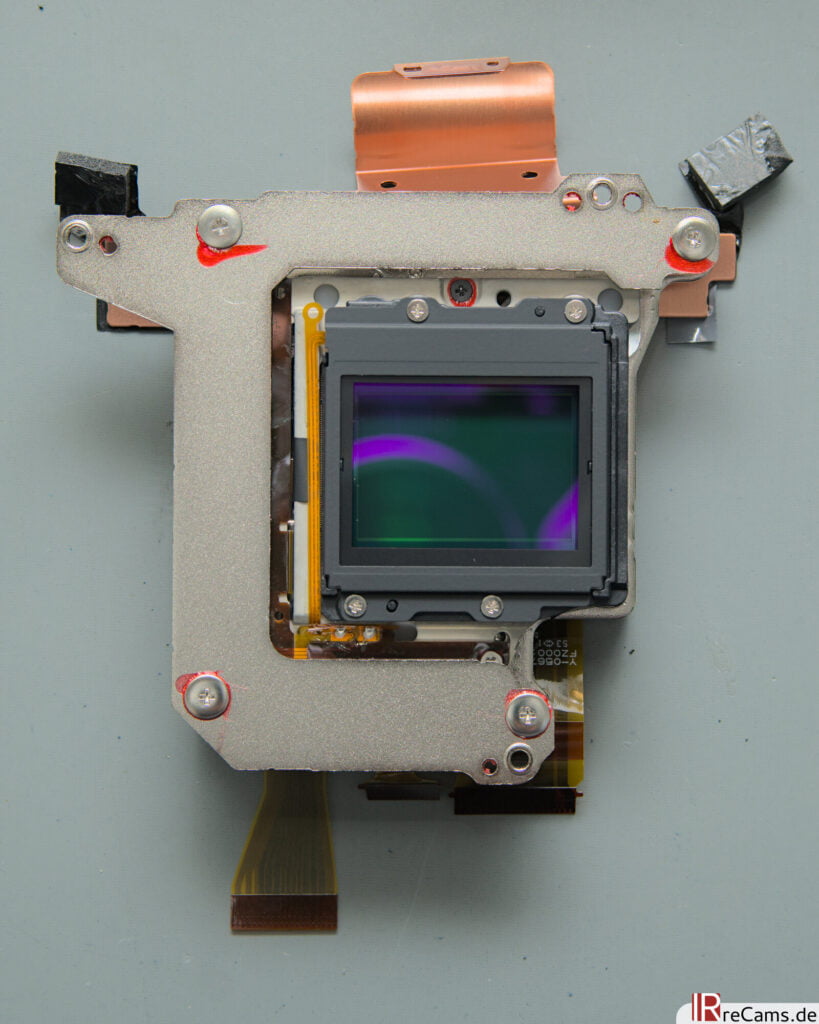
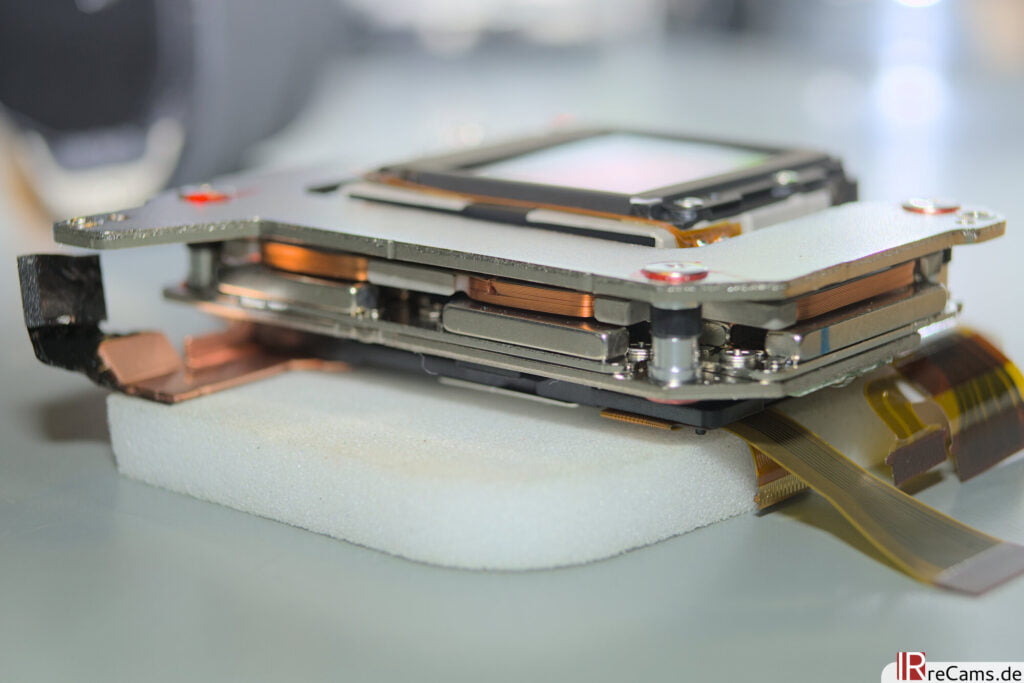
With all those pixels, it's obvious that the sensor must generate quite a bit of heat. This heat is tapped directly on the back of the sensor via a delicate heat sink and conducted to a copper plate on the stainless steel chassis. We had already seen at the beginning that the copper sheet makes contact with the upper part of the housing. A portion of the heat can therefore be conducted to the outside quite efficiently, I haven't seen such a design from any other manufacturer so far.

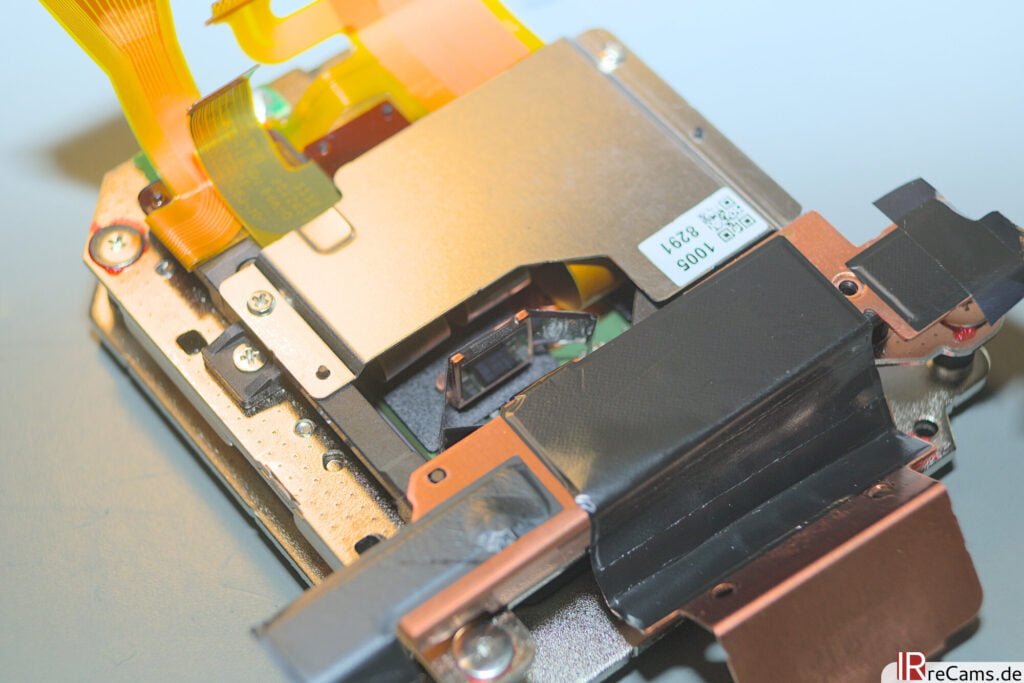
But now back to the actual point of this exercise: The blocking filter in front of the sensor is to be replaced by a 280 nm fullspectrum filter. As with virtually all modern Fuji cameras, the filter stack in front of the sensor consists of 2 glasses. The top glass has a piezoelectric element and is responsible for automatic dust cleaning. The actual UV/IR blocking filter (Hotmirror) is installed directly below it. As with the X-H1, X-T3 and X-T4, this blocking filter is unfortunately so unfavorably glued into the small plastic frame that the complete filter stack has to be replaced. This means that the dust cleaning function of the camera is lost with this model. Before the new filter is inserted, however, we can take a look directly at the new X-Trans 5 sensor. Admittedly, this is quite unspectacular, the pixels are very small after all...

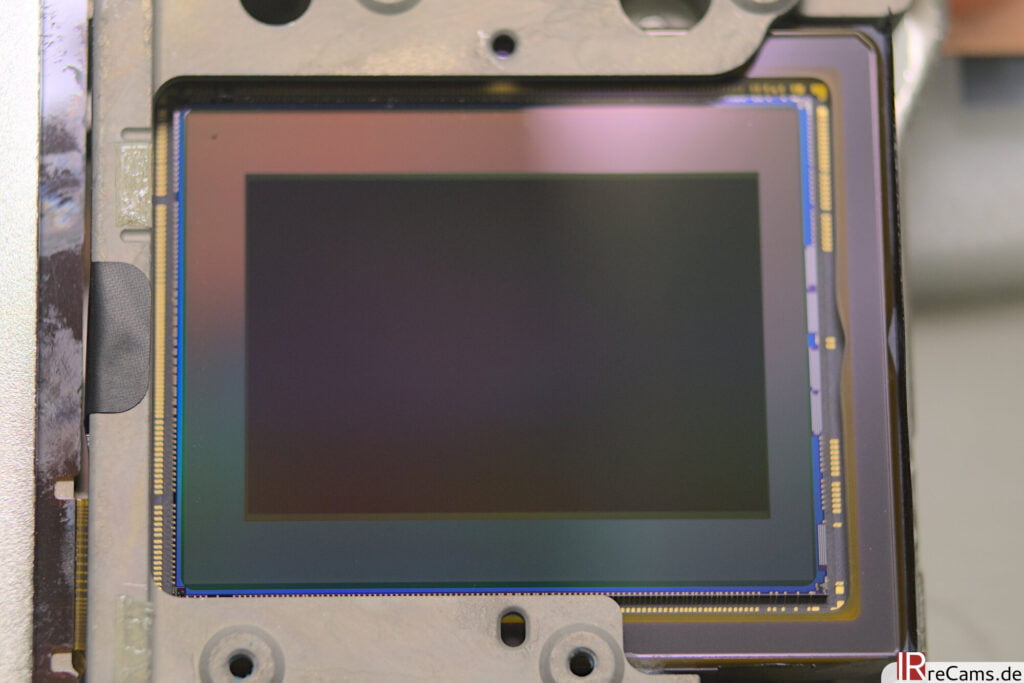
And this is what the finished sensor looks like after the new full spectrum filter glass plus sealing are installed in the camera. For comparison, the original filter stack that was removed is shown next to it. The sensor is now sensitive to the complete spectral range from UV over the visible range up to the infrared range ( estimated carefully 340 nm to 1,200 nm). By selectively choosing cut-off filters on the lens, it is now possible to take pictures in any part of the spectrum.
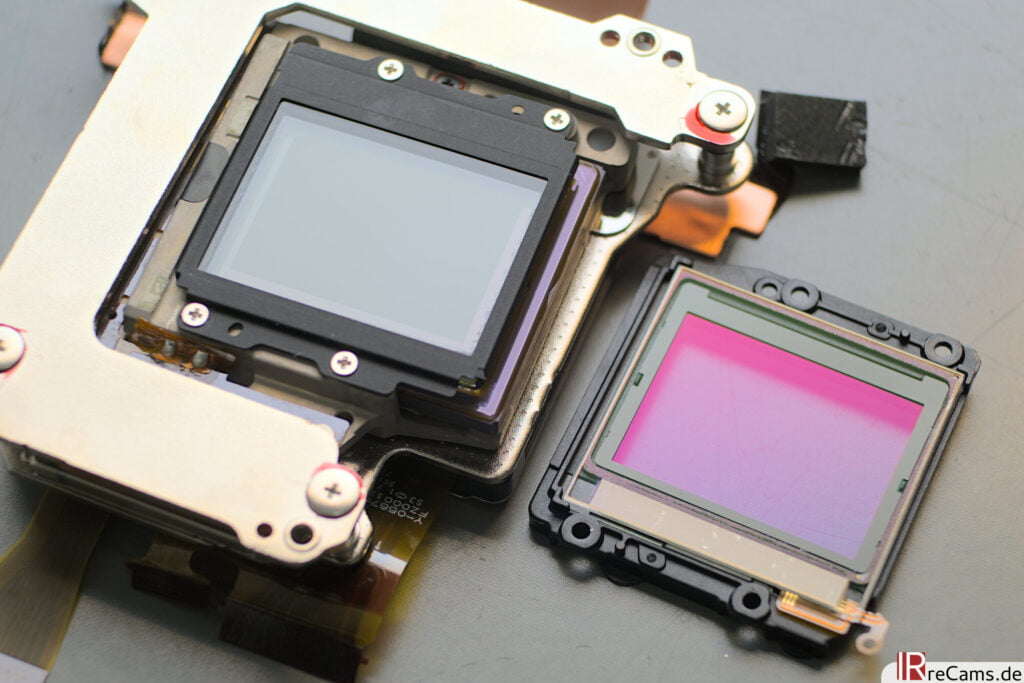
Of course, everything must now be reassembled. Since it's roughly the same process as disassembling, I'll spare you that here. Instead, we'll jump right to the infrared test shots. Last but not least, the camera has earned its knightly accolade after the reassembly: A fresh IR logo sticker now proudly covers the front of the housing.
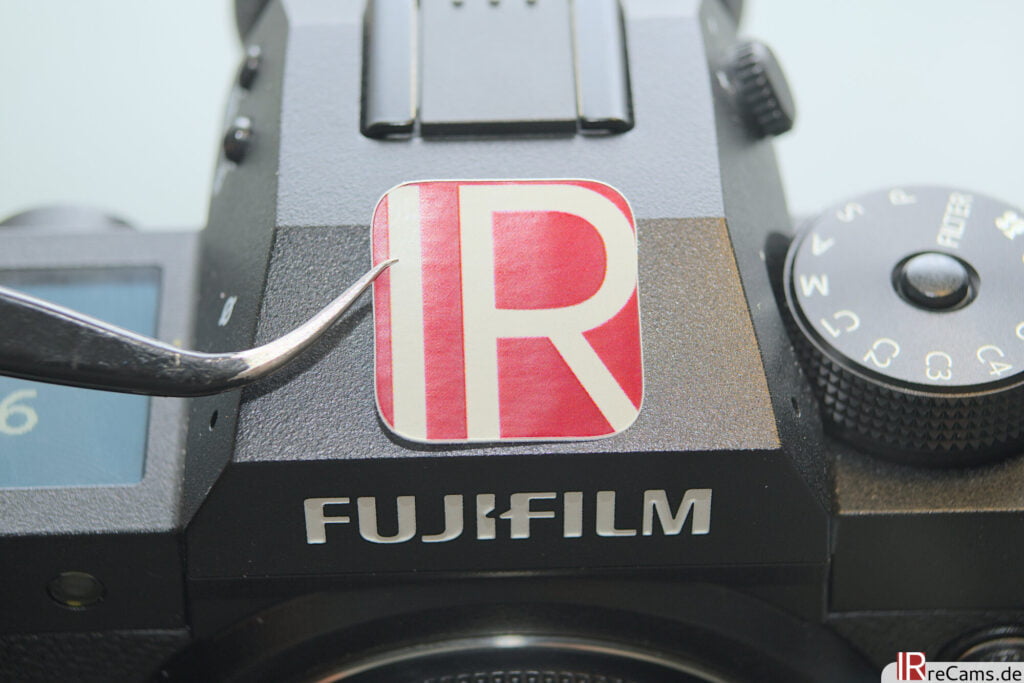
Internal Infrared LED
The first and perhaps most important test concerns the low-light and astro suitability of the camera. Some modern cameras have an internal infrared LED. Stray light from this LED can become visible on infrared images in low light conditions. Fortunately, a test shot of the converted X-H2 shows that the camera does not have an internal LED. The image is completely black after 30 s at ISO 51,200 (apart from the expected noise). This qualifies the X-H2 not only for an infrared camera conversion but also for an Astromodification in order to become sensitive for H-Alpha light.

Sensor Lines
Einige moderne Sensoren können feine, meist horizontale Linien in den Bildern zeigen. Schuld sind hier vermutlich PDAF Pixel (“AF Pixel”) auf dem Sensor. Diese treten vermehrt mit starken IR Filtern und bei sehr kontrastreichen Bearbeitungen auf. Wie schlägt sich die X-H2 mit einem 830 nm Infrarot Filter? Bei einer übertrieben kontrastreichen Bearbeitung sind bei 100 % Ansicht keine Linien oder andere Artefakte sichtbar (abgesehen vom Rauschen natürlich, induziert durch die kontrastreiche Bearbeitung). Der neue Sensor ist eine klare Empfehlung und kann uneingeschränkt benutzt werden.


Infrared Whitebalance
Unfortunately, the X-H2 shares the same handicap as all X-Trans cameras. The manual white balance is always set without any problems, but the available range is not quite sufficient. The example image was taken with a 630 nm filter, the white balance was set beforehand to a WhiteCard . Unfortunately, a warm magenta color cast remains in the camera and has to be corrected on the PC. Fujifilm can actually do that, with their Bayer sensor cameras (X-A series and X-Txxx) it works without any problems. The X-H2 seems to work a bit better than the X-T3, but you can't get rid of the color cast completely.
In the unlikely event that a Fujifilm firmware designer reads this: Please expand the limits in both color axes in which manual white balance can be set. A little bit wider and the cameras internal white balance will work for infrared as well. Such a change can be distributed in a future firmware update in my eyes and should neither harm anyone nor cause too much work in programming.



Infrared Resolution
Zugegeben, der Sprung von 26 MP der X-T4 auf 40 MP klingt erst einmal extrem viel (und das Marketing der Firmen macht uns das auch glauben). Tatsächlich steigt die Pixelzahl aber im Quadrat zur Auflösung, der neue Sensor hat also “nur” eine 24 % höhere Auflösung im Vergleich zum X-Trans 4 Sensor der letzten Generation. Mit anderen Worten, auf alle 4 Bildpunkte der X-T4 ist nun ein 5. Bildpunkt hinzu gekommen. Vor diesem Hintergrund ist die X-H2 kein Pixelmonster von einem anderen Stern, wohl aber eine willkommene Weiterentwicklung eines bewährten Sensors.
The increased resolution also benefits us in Infrared Photography. At least as long as the lens produces a good image and the sharpness is adequate. In general, the lenses in IR draw a little softer and you lose some detail with many lenses. This depends on the lens and it is difficult to generalize. But what can be said as a rule: You should avoid stopping down a lot, especially with the X-H2. The longer wavelength infrared radiation is more affected by diffraction - and this is of course much more noticeable on a high-resolution sensor.
Here is the comparison 26 MP vs 40 MP under optimal conditions with 100% crop in each case:



Infrared Photography with the X-H2
The colors that the camera can produce with various Infrared Filters , are as good as usual, and there are no problems or differences to the well-known X-Trans sensors. Once the white balance is set correctly in the software, the camera is just fun to use.

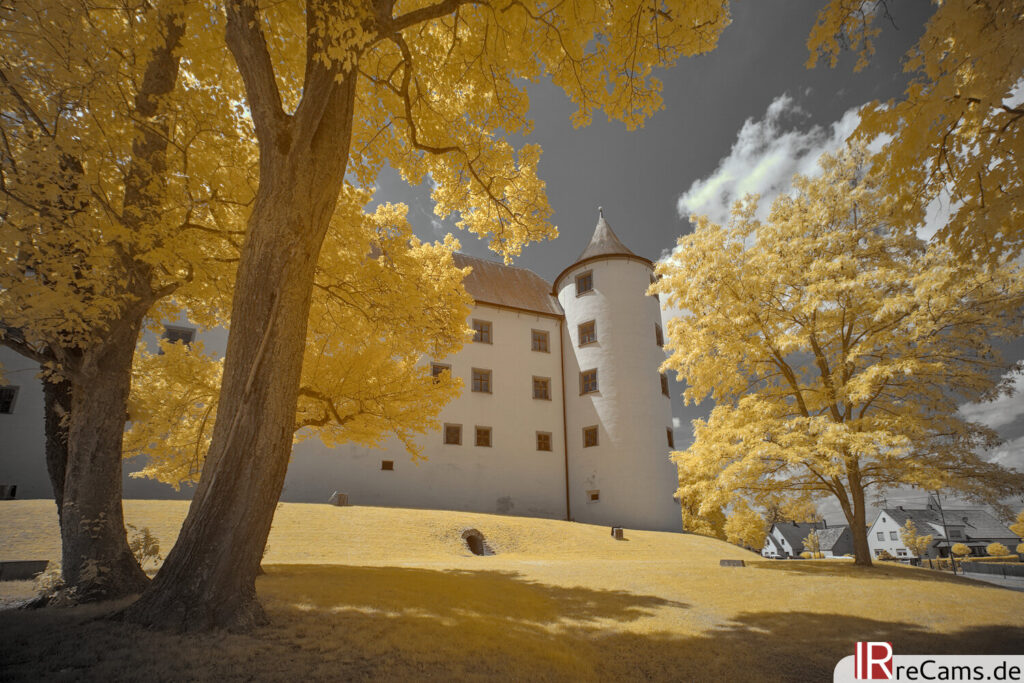

As expected, the sensor's noise behavior and dynamics are great - the images do not fall apart even with a high contrast Infrared scene. The sensor performance is on par with virtually all modern sensors - it feels like a plateau was reached a few years ago and you could almost get the feeling that CMOS technology has matured.

Summary
The Fujifilm X-H2 is a complex camera that boasts remarkable specs and delivers great image quality. The camera's construction and design are solid, uncompromising, and optimized for dissipating heat. Accordingly, the camera can shoot for a very long time with fast frame rates or create video in 8K. The 40 MP resolution is a welcome update to the existing sensors and also delivers more details in infrared than the predecessors.
Die Frage bleibt natürlich, ob man dieses Mehr an Auflösung wirklich benötigt. Wie auch in der “normalen” Fotografie muss man sagen: “Kommt drauf an”. Auch mit den 26 MP Sensoren kann man großartige Infrarot Bilder aufnehmen und diese in toller Qualität drucken. Vor ein paar Jahren habe ich eine 10 MP Infrarot Aufnahme einer alten Pentax auf eine 1 Meter große Leinwand gedruckt. Trotz anfänglicher Bedenken sieht das Ergebnis absolut großartig aus und man vermisst bei einem normalen Betrachtungsabstand keine Details. Es muss also nicht immer das neueste und beste sein, aber es macht natürlich trotzdem Spaß damit zu arbeiten. Die X-H2 und X-H2s sind ab sofort im Shop für einen Infrared, Fullspectrum or Astro modification .
